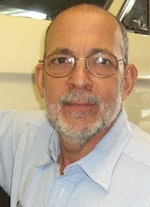The sound of a John Phillip Souza march shattered my sleep at 5:30 as the radio loudly insisted it was time to wake up. The music was loud – too loud. It was certainly loud enough to get me up, perhaps even loud enough to wake the people in the next room.
I forced myself to sit up. Five-thirty is a particularly obnoxious hour to get up when you arrived at the hotel just five hours earlier after a full day spent on the road, in an airport or cramped in the airborne equivalent of a bus. That kind of agony should take you to someplace “cool” – someplace like Hawaii, Europe, or Asia – and not just to the other side of the same continent.It certainly wasn’t the nature of the missions that captured my attention.I was so exhausted I forgot to check ‘essentials’ before I went toes up: essentials like the kind of music the previous guest had chosen to awaken with, and perhaps even more important, where the volume control was set. At that hour, I was thinking about two things and two things only: getting at least a couple of hours of sleep before my seminar that morning, and waking up on time. Consequently, I called the desk and requested a 5:40 wake-up call, set the radio alarm for 5:30, the buzzer for 5:45 and my own little travel clock for 6:00. It’s not that I’m neurotic, although I would hate to have to argue that I’m not, but after traveling all day, the fear of oversleeping is very real.I tried not to drown myself in the shower and struggled not to cut my nose off as I shaved. Then, I stumbled my way to the breakfast buffet. Somewhere around the time my body and my mind began to function in concert, I noticed five young men in camouflaged flight suits huddled together at the table immediately to my left.I remembered a sign near the elevators welcoming a combat fighter squadron to the hotel, but I also remembered not really giving it much thought. Now, I was confronted with five fighter pilots diligently working their way through a series of training exercises scheduled to take place that morning and afternoon.
Nothing left to chance I wasn’t really eavesdropping. But, it wasn’t like I could ignore them either. They were just about on top of me taking turns working their way through every detail, every aspect of the missions that would fill their morning and afternoon, and I found myself compelled to follow along with them as they did that.It certainly wasn’t the nature of the missions that captured my attention. It was the process they followed that intrigued me. Each of these five pilots took a turn at briefing the others on at least one aspect of the mission until every aspect of the mission was fully addressed and understood. No detail of the mission was too small. No aspect of the mission was taken for granted. No responsibility was left unassigned. Nothing was left to chance.They ‘flew’ the morning’s mission at the breakfast table, putting every conceivable contingency to rest before anyone headed for the airport. As the briefing moved around the table, they identified and discussed their targets, how they would approach, who would lead the first strike and the very specific responsibilities of each member of the group. They talked about where and at what altitude they would meet their tanker and the procedures for refueling on the way to the target. They talked about their second- and third-level targets in the event they were diverted from their original target and the ‘targets of opportunity’ that might materialize unexpectedly in the course of flying the mission.That is why nothing was assumed. That is why nothing was taken for granted.I marveled at the meticulous attention to every detail of the mission: the who, what, where, when, why and how of the mission’s execution.These were ‘kids’: kids not that long out of their teens. And, yet you could tell they were seasoned veterans, warriors not long removed from the battle. You could tell it in their eyes. You could tell it in their demeanor. But, more than that, you could tell it from the deadly seriousness with which they approached the morning and afternoon’s work.
They could have relaxed just a little. After all, it wasn’t like this was a ‘real mission’ with ‘real targets’ and a ‘real enemy.’ This was just a training mission, certainly not the ‘real thing.’But, these kids seemed to realize even more than most that excellence in execution isn’t just the result of endless training, although that is certainly a part of it. It isn’t an infinite number of hours spent in practice or simulation either. It is the recognition that practice in and of itself is not enough; it is the realization that if perfect execution is your goal, nothing less than perfect practice and simulation will do. That is why nothing was left to chance. That is why nothing was assumed. That is why nothing was taken for granted.
Common goals and objectives
My eggs got cold and my toast got hard as I watched and listened and learned. There was a lesson here, a not so subtle lesson that had at its heart the way to approach life: the way to attack living. These young warriors understood that in their particular line of work there is no room for error. The only way to avoid mistakes is to embrace the fact that they can occur and then plan and practice for any eventuality tirelessly and perfectly, so that when they do, you are prepared.
By the time I was ready to leave for my seminar there were three or four other groups huddled together in the restaurant courtyard. The five pilots I was observing got up just as I did. As we stood at the cashier’s counter waiting to pay, I couldn’t help but ask where they were from and what they were doing, even though I already knew.One of the pilots turned to me, smiled and explained that the exercises I had heard them preparing for were a part of their preflight briefing process. I told him just how impressed I was watching and listening to the detail and intricate planning. He smiled again and said nothing less would do. Then, he started talking about leadership issues; only it was obvious that he didn’t seem to think of them as leadership issues at all. In fact, he made them sound pretty ordinary, when in fact they’re anything but.He told me that everyone involved in the flawless and successful execution of a mission — any mission — had to understand that success as a team is predicated on shared values, commonality of purpose and a clear understanding of the responsibilities of both the individual and the group. If done correctly, the organization becomes stronger without sacrificing the creativity and uniqueness of each individual.He looked over at his four associates and continued, “There are a number of elements involved in combat and many of them have parallels in business. Shared values are critical, as is a sense of being part of something greater than yourself. You have to work as a team, and you can’t do that without a set of common goals and objectives. There has to be discipline, determination, attention to detail, confidence and a strong sense of duty: a strong sense of purpose.“Success is impossible without flawless execution and flawless execution is impossible without perfect practice and a commitment to continuously improving your own personal performance as well as the performance of the group. Success is equally impossible if the mission isn’t clearly defined or understood.“The key is focus, flexibility and the speed with which you are able to separate a real threat from an imagined one, the speed with which you are able to react appropriately.”
Ground “combat” I thanked him for being there for all of us, for his commitment as well as the commitment and sacrifice of his fellow officers. As he walked away and I headed for my presentation, I started to think about what had just transpired. The squadron was headed for the airport and a full day of training. I was headed for a full day of training on the ground. We would all be dealing with a number of the same issues: commitment, values, mission, vision, goals, objectives, tactics, support, teamwork, logistics, flexibility, intelligence and information, administration, preparation and execution.We would all be dealing with virtually the same concept of success and the high degree of situational awareness and focus required regardless of the mission. Combat — combat in business or in the air — requires an awareness of both the challenges and threats that must be both confronted and then overcome.It seemed as if the first stages of their briefing had just been completed, as the first stages of mine were about to begin. They were consumed with threats and targets and successfully accomplishing the objectives that would define a successful mission. I was about to start the morning with a number of key automotive service management concepts.As the morning developed, I couldn’t help but realize that the nature of business and the nature of combat are both elegantly simple and very similar. They both begin with confrontation. They both involve accomplishing strategic goals and objectives. They both result in winners and losers. And, ultimately, they both require mission critical planning, consideration and flawless execution for success. And, while the stakes may be higher and the enemies significantly more dangerous in combat, success in business requires many of the same skills, abilities, attention to detail and flawless execution that success in a combat situation on the ground or in the air might.You can’t do that if you are constantly distracted. You can’t do it if you won’t take the time or make the effort. Planning is a mission-critical activity. It is just as essential to your success as it was to the success of the pilots eating breakfast and planning their missions at the hotel that morning. The only difference is the price of failure.The failure to adequately plan, the inability to focus, a momentary loss of concentration or less than perfect execution can be costly in either business or combat. In business, the losses are figured in terms of time and money and not much else. In combat, the cost can be significantly higher.
Editor’s Note: Motor Age congratulates Mitch on passing the remainder of his ASE certification exams this past May and recertifying as an ASE Master Technician. Job well done!
I forced myself to sit up. Five-thirty is a particularly obnoxious hour to get up when you arrived at the hotel just five hours earlier after a full day spent on the road, in an airport or cramped in the airborne equivalent of a bus. That kind of agony should take you to someplace “cool” – someplace like Hawaii, Europe, or Asia – and not just to the other side of the same continent.It certainly wasn’t the nature of the missions that captured my attention.I was so exhausted I forgot to check ‘essentials’ before I went toes up: essentials like the kind of music the previous guest had chosen to awaken with, and perhaps even more important, where the volume control was set. At that hour, I was thinking about two things and two things only: getting at least a couple of hours of sleep before my seminar that morning, and waking up on time. Consequently, I called the desk and requested a 5:40 wake-up call, set the radio alarm for 5:30, the buzzer for 5:45 and my own little travel clock for 6:00. It’s not that I’m neurotic, although I would hate to have to argue that I’m not, but after traveling all day, the fear of oversleeping is very real.I tried not to drown myself in the shower and struggled not to cut my nose off as I shaved. Then, I stumbled my way to the breakfast buffet. Somewhere around the time my body and my mind began to function in concert, I noticed five young men in camouflaged flight suits huddled together at the table immediately to my left.I remembered a sign near the elevators welcoming a combat fighter squadron to the hotel, but I also remembered not really giving it much thought. Now, I was confronted with five fighter pilots diligently working their way through a series of training exercises scheduled to take place that morning and afternoon.
Nothing left to chance I wasn’t really eavesdropping. But, it wasn’t like I could ignore them either. They were just about on top of me taking turns working their way through every detail, every aspect of the missions that would fill their morning and afternoon, and I found myself compelled to follow along with them as they did that.It certainly wasn’t the nature of the missions that captured my attention. It was the process they followed that intrigued me. Each of these five pilots took a turn at briefing the others on at least one aspect of the mission until every aspect of the mission was fully addressed and understood. No detail of the mission was too small. No aspect of the mission was taken for granted. No responsibility was left unassigned. Nothing was left to chance.They ‘flew’ the morning’s mission at the breakfast table, putting every conceivable contingency to rest before anyone headed for the airport. As the briefing moved around the table, they identified and discussed their targets, how they would approach, who would lead the first strike and the very specific responsibilities of each member of the group. They talked about where and at what altitude they would meet their tanker and the procedures for refueling on the way to the target. They talked about their second- and third-level targets in the event they were diverted from their original target and the ‘targets of opportunity’ that might materialize unexpectedly in the course of flying the mission.That is why nothing was assumed. That is why nothing was taken for granted.I marveled at the meticulous attention to every detail of the mission: the who, what, where, when, why and how of the mission’s execution.These were ‘kids’: kids not that long out of their teens. And, yet you could tell they were seasoned veterans, warriors not long removed from the battle. You could tell it in their eyes. You could tell it in their demeanor. But, more than that, you could tell it from the deadly seriousness with which they approached the morning and afternoon’s work.
They could have relaxed just a little. After all, it wasn’t like this was a ‘real mission’ with ‘real targets’ and a ‘real enemy.’ This was just a training mission, certainly not the ‘real thing.’But, these kids seemed to realize even more than most that excellence in execution isn’t just the result of endless training, although that is certainly a part of it. It isn’t an infinite number of hours spent in practice or simulation either. It is the recognition that practice in and of itself is not enough; it is the realization that if perfect execution is your goal, nothing less than perfect practice and simulation will do. That is why nothing was left to chance. That is why nothing was assumed. That is why nothing was taken for granted.
Common goals and objectives
My eggs got cold and my toast got hard as I watched and listened and learned. There was a lesson here, a not so subtle lesson that had at its heart the way to approach life: the way to attack living. These young warriors understood that in their particular line of work there is no room for error. The only way to avoid mistakes is to embrace the fact that they can occur and then plan and practice for any eventuality tirelessly and perfectly, so that when they do, you are prepared.
By the time I was ready to leave for my seminar there were three or four other groups huddled together in the restaurant courtyard. The five pilots I was observing got up just as I did. As we stood at the cashier’s counter waiting to pay, I couldn’t help but ask where they were from and what they were doing, even though I already knew.One of the pilots turned to me, smiled and explained that the exercises I had heard them preparing for were a part of their preflight briefing process. I told him just how impressed I was watching and listening to the detail and intricate planning. He smiled again and said nothing less would do. Then, he started talking about leadership issues; only it was obvious that he didn’t seem to think of them as leadership issues at all. In fact, he made them sound pretty ordinary, when in fact they’re anything but.He told me that everyone involved in the flawless and successful execution of a mission — any mission — had to understand that success as a team is predicated on shared values, commonality of purpose and a clear understanding of the responsibilities of both the individual and the group. If done correctly, the organization becomes stronger without sacrificing the creativity and uniqueness of each individual.He looked over at his four associates and continued, “There are a number of elements involved in combat and many of them have parallels in business. Shared values are critical, as is a sense of being part of something greater than yourself. You have to work as a team, and you can’t do that without a set of common goals and objectives. There has to be discipline, determination, attention to detail, confidence and a strong sense of duty: a strong sense of purpose.“Success is impossible without flawless execution and flawless execution is impossible without perfect practice and a commitment to continuously improving your own personal performance as well as the performance of the group. Success is equally impossible if the mission isn’t clearly defined or understood.“The key is focus, flexibility and the speed with which you are able to separate a real threat from an imagined one, the speed with which you are able to react appropriately.”
Ground “combat” I thanked him for being there for all of us, for his commitment as well as the commitment and sacrifice of his fellow officers. As he walked away and I headed for my presentation, I started to think about what had just transpired. The squadron was headed for the airport and a full day of training. I was headed for a full day of training on the ground. We would all be dealing with a number of the same issues: commitment, values, mission, vision, goals, objectives, tactics, support, teamwork, logistics, flexibility, intelligence and information, administration, preparation and execution.We would all be dealing with virtually the same concept of success and the high degree of situational awareness and focus required regardless of the mission. Combat — combat in business or in the air — requires an awareness of both the challenges and threats that must be both confronted and then overcome.It seemed as if the first stages of their briefing had just been completed, as the first stages of mine were about to begin. They were consumed with threats and targets and successfully accomplishing the objectives that would define a successful mission. I was about to start the morning with a number of key automotive service management concepts.As the morning developed, I couldn’t help but realize that the nature of business and the nature of combat are both elegantly simple and very similar. They both begin with confrontation. They both involve accomplishing strategic goals and objectives. They both result in winners and losers. And, ultimately, they both require mission critical planning, consideration and flawless execution for success. And, while the stakes may be higher and the enemies significantly more dangerous in combat, success in business requires many of the same skills, abilities, attention to detail and flawless execution that success in a combat situation on the ground or in the air might.You can’t do that if you are constantly distracted. You can’t do it if you won’t take the time or make the effort. Planning is a mission-critical activity. It is just as essential to your success as it was to the success of the pilots eating breakfast and planning their missions at the hotel that morning. The only difference is the price of failure.The failure to adequately plan, the inability to focus, a momentary loss of concentration or less than perfect execution can be costly in either business or combat. In business, the losses are figured in terms of time and money and not much else. In combat, the cost can be significantly higher.
Editor’s Note: Motor Age congratulates Mitch on passing the remainder of his ASE certification exams this past May and recertifying as an ASE Master Technician. Job well done!




